Ah, nostalgia.
Oftentimes, when a team is struggling or rebuilding, this type of post offers some faint hope that a fanbase can cling onto; a light at the end of the tunnel, if you will. Considering this, it is almost a weird time for a Carolina Hurricanes look-ahead. The team is quite good in the present, despite their five-game shutdown at the hands of the Tampa Bay Lightning in the second round of the playoffs, and there’s really no sense in looking towards the future for the fans. One would hate to miss what they put on the ice these days.
However, starting with this current 2021 offseason, the team’s salary cap situation suggests this team has an opportunity to take the next step and potentially, truly enter the category of the top-end Stanley Cup contenders. With general manager Don Waddell and company reportedly looking to aggressively fill the needs they have identified, look for quite a bit of wheeling and dealing between the two drafts this summer — the entry and expansion drafts both present opportunities to identify teams looking to shake things up and perhaps find the next Teuvo Teravainen-robbery-from-Chicago deal. Especially with the flat cap continuing in 2021-22, teams will need to shed salary and not lose players to Seattle for nothing.
The Hurricanes are already on the verge of Cup contention, but with a few shrewd moves over the next few years could truly be one of hockey’s elite teams, a year-in-and-out threat, such as the Lightning or Pittsburgh Penguins of the mid-2010’s. These types of exercises are fun, because they mix prospect projection and roster transactions, as well as player progression and regression.
The Hurricanes are in a fantastic position in terms of young, controlled assets, so it’s quite possibly the best time to take a shot at which players will be breaking through, and just how this roster could potentially look in a few years. So, let’s combine playing general manager and the logical progression of the farm system and roster, and see what we come up with. This is my (surely wrong) glimpse into the future, exploring how the Hurricanes’ roster will look three years from now on opening night for the 2024-25 NHL season. If nothing else, when the actual time comes we can look back with a laugh at how far off I was.
Forwards
Line 1: Teuvo Teravainen – Sebastian Aho – Andrei Svechnikov
We’ll start with the easiest choice I’ll likely have today — does anyone really expect this to change?
This trio was placed together for the first time in the 2019-20 season, and for a long stretch was probably one of the best lines in hockey, likely behind only the Boston Bruins’ and Colorado Avalanche’s top units. Head coach Rod Brind’Amour has shown a hesitancy to use it at times in lieu of lengthening his lineup, but the bolstering of the forward ranks as well as soon-to-arrive talent we’ll discuss later should make this idea moot.
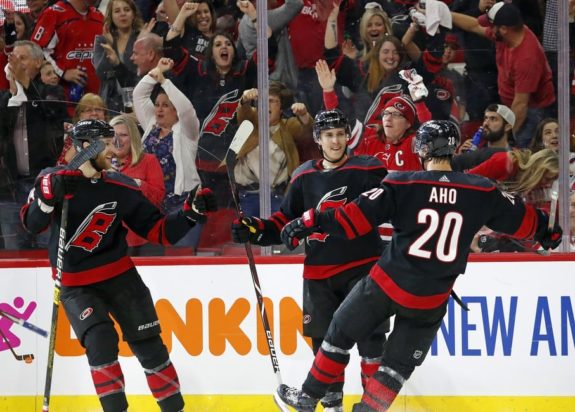
Both Aho and Teravainen will be pending unrestricted free agents (UFA) after the 2023-24 season, so there could very well be storylines galore heading into the campaign (assuming neither sign extensions during the prior season). Svechnikov seems a likely candidate for a bridge deal in the summer of 2021, and with both of his linemates’ contracts up in the summer of 2024, I see a two-year deal being most likely, so they can get a read on his value and get him inked long-term first. Leaving all three contracts for one summer would be, um, stressful.
Assuming Teravainen’s tough, injury-shortened 2020-21 season is simply a blip on the radar, this line projects to be one of hockey’s best over the next few seasons. Aho and Teravainen are already established, two-way stars, and Svechnikov is a blossoming supernova with the potential to be one of the five best players on the planet, despite a tough age-21 season filled with ups and downs. He still has as much raw skill as any player I have watched wear a Hurricanes uniform. Expect these three guys to each be over point-per-game players, feeding off one another and spearheading the team’s contention window for the foreseeable future.
Line 2: Matthew Tkachuk – Vincent Trocheck – Seth Jarvis
Filling out what could be a nasty top-six, I have two superbly talented young players flanking centerman Vincent Trocheck, who has gotten his career back on track with a monster season in Carolina. His seamless fit in the system makes me think he’s a player the Hurricanes will likely extend once his contract is up in the summer of 2022. This trio would be a lot of a fun, as all three guys have dynamic skillsets, can both set up and score goals, and two of the three are proven pests that will play a heavy game and irritate the opposition. The Hurricanes desperately need more of that.
If you look throughout the forward listing here, here we have one of the few spots that wasn’t filled in-house logically, and that comes with the Hurricanes’ need for a bit more of a nasty streak in their game. I had a few different ideas to put in this spot, but then the news came out that Matthew Tkachuk may be on the way out from Calgary. Now, I will say, the odds of the Hurricanes acquiring him are slim. Very rarely do young, highly drafted, legitimate top-six forwards with a mean streak in their game come available. Many logical destinations are out there, with St. Louis and Ottawa coming to mind right off the bat, and surely half the league or more will at least be poking around to get a ballpark idea of the cost.
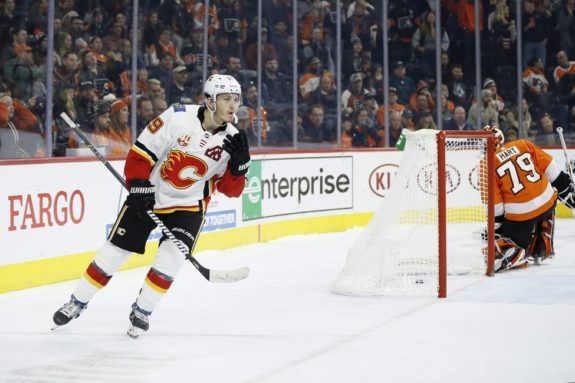
However, for this exercise, and with Tkachuk absolutely, perfectly fitting what I think the Hurricanes need to make the next step, as well as Carolina possessing the assets needed to swing a deal, I decided to pull the trigger and stick him into the lineup. You’ll notice one of the Hurricanes’ young stars missing in Martin Necas. If the organization were to make a deal with the Calgary Flames for Tkachuk, I think Necas would be a good centerpiece to send back along with a prospect, such as Finnish playmaker Tuukka Tieksola or rising two-way center Jack Drury. Necas has showcased astronomical upside for the Hurricanes in the regular season, but has disappeared in both of his postseasons to date. It’s possible he bulks up and learns how to play a style of hockey more effective in the playoffs; he is only 22, after all. But Tkachuk would certainly be worth giving up his potential upside.
On the other side, Jarvis, the Hurricanes’ top prospect, will be 22 years of age, and by this time I expect him to be established in the NHL; there’s a good chance he already has a 20-25 goal rookie season on his resume by then. He has as much upside as anyone in the organization outside of the three guys on the top line, and his goal-scoring punch will be a welcome sight in the lineup. Incidentally, while I know many Hurricanes fans are eager to see him next season, the organization won’t rush him and his full-time insertion into the lineup probably won’t come until the 2022-23 season; losing most of a year of development hurt his chances more than people probably realize. Like all prospects, he needs to play and get experience.
Line 3: Ryan Suzuki – Jordan Staal – Brandon Saad
Another area the Hurricanes need to look to upgrade is their depth scoring. While the top of the lineup has proven itself able to match with anyone, one of the biggest lessons from the postseason was how elite teams like the Lightning have legitimate scoring threats throughout the lineup. Hell, Tyler Johnson was playing on their fourth line in the postseason. Incidentally, don’t be surprised if the Hurricanes take a look at two pending UFA Lightning players, Barclay Goodrow and Blake Coleman, both bottom-six forwards that are also legitimate secondary-scoring threats threats, this summer.
Instead, we look to Avalanche veteran winger Brandon Saad. Colorado is in a bit of a cap crunch this summer, with captain Gabriel Landeskog needing a new contract. Oh, and some defenseman named after a salad might need a bit of a pay raise coming off his rookie deal (I don’t get paid to write jokes, I’m sorry). Is 94 points in the first 101 regular season games of a career good? What about for a defenseman? And what about the 31 points in 35 postseason games? Hard to say.
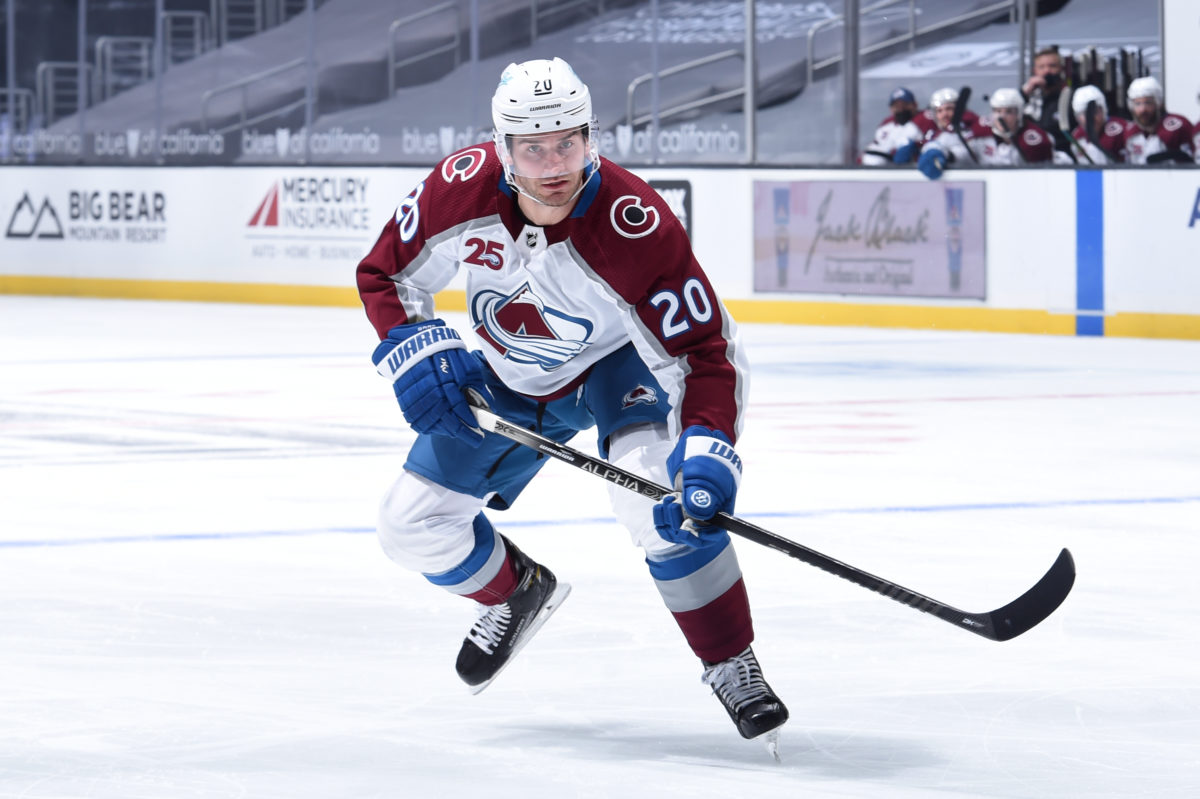
Anyway, apologies for the sidetrack, but Saad would make a fantastic addition as a veteran power forward and proven around 25-goal scorer, that is still somehow only 28 years old today. A four-year deal makes sense, though he could potentially slow down a touch with his playing style towards the end of the term. His speed is a big part of his game, so the team would need to take that into consideration, but the fit still seems seamless and would give the Hurricanes some more scoring punch in the middle six. He is also a player that could move up and down the lineup with injuries or whatever situations arise, and likely be just as comfortable and effective with Aho as he would be on the third line.
The captain, Staal, is set for unrestricted free agency in the summer of 2023, but I fully expect him to finish out his career in Raleigh barring something unforeseen. He’s as good a buffer between coach and roster as there is in the NHL, a fantastic representation of the coach’s philosophy leading the way on the ice. He will be 36 in 2024, so his cap hit should help free up some room for the other players listed throughout here. It’s hard to say if his offensive outburst in 2020-21 is legitimate or just a one-off, but even when he isn’t scoring at a second-line rate, he flat-out makes his teams better. I expect him to have a roster spot, and the “C” on his crest, until he decides to hang up the skates.
Suzuki is another top prospect for the Hurricanes, and while I think he could play higher in a lot of lineups within a few years, he also showed a heavier side to his game whilst playing on the fourth line for Team Canada at the World Juniors. This is going to serve him well when he tries to break into the Hurricanes lineup, and his speed and playmaking will help further buff the bottom of this lineup. Despite technically being a bottom-six player here, he will also surely see plenty of power-play time where his talent and vision will be on full display. This hypothetically gives the Hurricanes three dangerous lines, capable of scoring consistently against any opposing unit.
Line 4: Brock McGinn – Steven Lorentz – Jamieson Rees
Lorentz won the affections of Brind’Amour and all of Caniac Nation in his rookie season. He’s good in the faceoff circle, winning over half his draws as a rookie, and has a combination of speed and a long reach that allowed him to be a pest defensively. He clearly, and quickly, won his coach’s trust to be used in all situations, and has more offensive upside than his snakebitten rookie season would suggest. His attitude and energy also makes him a great fit to stick around in the fourth-line center role.
On the left side, it basically comes down to McGinn and Warren Foegele, who are both free agents in the 2021 offseason. Foegele is reportedly looking for a larger role and a pay increase, and I do not expect the Hurricanes to provide either of those. McGinn would be my personal choice of the two anyway, as he provides better penalty killing and physicality while offering basically the same offensive production. McGinn seems like a quintessential Brind’Amour player who probably won’t be going anywhere for a long time.
Lastly, and one of the reasons I didn’t decide to go with Coleman above, even though I do think he would make for a great addition to this lineup, is because the Hurricanes have a quite similar, homegrown version on the way in Rees. If you know me or follow me on Twitter you know how I feel about the Hamilton, Ontario-native, as his style of play as a talented, but incredibly-annoying-to-play-against forward is one of the most enjoyable styles for me, personally, to watch.
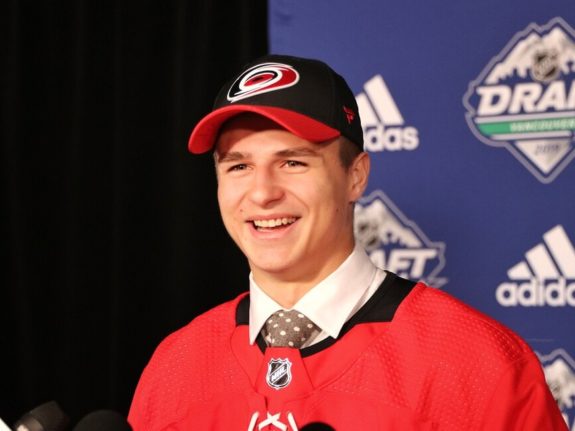
In addition to a heavy game, much more imposing than his measurables would suggest, Rees has great speed, hands, and excellent vision. He has second-line upside, but enough versatility to break in with great success on the fourth line as well. Expect him to be a fan-favorite in Raleigh soon after his debut.
Defense
Pairing 1: Jaccob Slavin – Brett Pesce
Two players that are basically the cornerstone of the Hurricanes defense, this choice was just about as easy as the first line in the forward ranks. You could basically flip Pesce and the second-pairing right defenseman below, but for the argument I’m about to make, we’ll leave this pair together.
The Dougie Hamilton situation is fluid, and tough to predict which way it’ll go. The Hurricanes would obviously love to have his offensive production back, but with many upgrades necessary and a Svechnikov extension forthcoming, they will not handicap themselves by paying Hamilton a massive extension. I think the team is hoping to strike a deal that works for both sides, but if he wants market rate, or anything near Alex Pietrangelo money, they’re prepared to move on. So, for the sake of not being boring and just keeping a bunch of players in tow for this exercise, we’ll say Dougie walks (I honestly think it’s about as 50/50 as it gets). I’ve seen many people ask “well then, who’s going to be your number one right-shot defenseman!? You’ll have to pay someone else anyway!” How short our memories can be.
As recently as two years ago, Pesce and Slavin made their names for themselves playing together as one of the most dominant shutdown pairings the Hurricanes have ever had. They both combine size, strength, mobility, and elite defensive IQ, showing the aptitude in their own ends to shut down anyone — anyone — in the NHL. Who can forget the clinic Slavin put on against Connor McDavid two years ago? Furthermore, with Slavin regularly paired with Hamilton, it was actually Pesce that was frequently tasked with the Barkovs, Kucherovs, and other elite forwards of the Discover Central Division, matchups of which he handled with aplomb more often than not.
So, no, the Hurricanes don’t need another top-pairing defenseman that’s going to cost $7-8 million. They have a pairing they know works that they can easily fall back on, and can therefore look to add a second-pairing, right-shot defenseman that can run the power play, while saving that cap space for improvements and extensions elsewhere.
Pairing 2: Brady Skjei – Matt Dumba
So, with that last point in mind, how about Dumba? A UFA in the summer of 2023, Dumba has some red flags to consider. His offensive production in the last two seasons hasn’t matched the elite level we saw from 2015-2019, and he has an injury history that may be directly related to that decline in his numbers. On the flip side, he continues to be above average pretty much across the board in other areas of the game, from defense to generating chances and exiting his own end. A team like the Hurricanes could be a perfect opportunity and match for Dumba, as his lack of production could potentially knock his value down a touch, but playing in a system — and with the talent — on a potential Cup contender could set him up for a big bounce-back offensively.
This holds especially true if Brind’Amour decides to put him on the top unit with Slavin, so that Skjei and Pesce could stay together — let’s not pretend every defenseman that suits up next to Slavin doesn’t get a huge boost, simply from the confidence provided by playing next to one of the best defenders in hockey. There’s a freedom that comes with it, the ability to jump up in the play without fear, knowing a 2-on-1 eraser will cover your potential mistakes a solid 95 percent of the time.
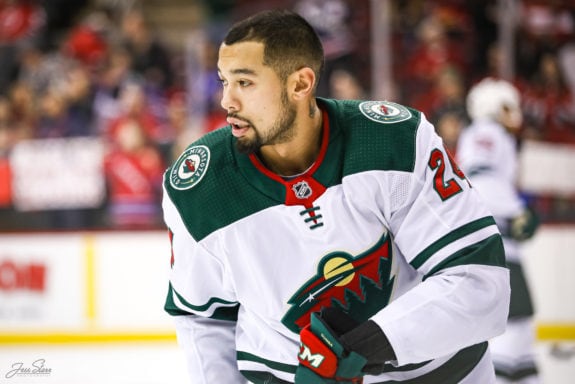
Speaking of Skjei, it wasn’t long ago that he was a candidate for a cap-saving move, such as potentially shipping him off to Seattle along with an asset to get the contract off the books. Now, with his absolutely fantastic play down the stretch and into the postseason, I think he’s pretty much a lock to be protected in the upcoming Seattle Expansion Draft. The more interesting consideration is his unrestricted free agency the summer before the 2024-25 season begins. I think he ends up back in Raleigh, although he shouldn’t quite get $5.4 million again; if he wants similar money, much less a raise, the Hurricanes will likely look elsewhere, and should be able to find a suitable replacement on the second pairing for $4.5 million at most.
Pairing 3: Jake Bean – Scott Mayfield
This one is really tough for me, and it was extremely tempting to go with Jesper Sellgren in the LD3 slot. Sellgren is a non-flashy, but extremely effective two-way defenseman that has shown much to like both in the SHL and in his brief AHL stint, where he scored three goals and displaced some veteran AHLers in his 11-game postseason run. Sellgren is probably NHL-ready right now, but I’m not sure is much more than a No. 5 on a contending team. So, although Bean certainly has more upside, I’m not sure he is cut out to be a third-pairing defenseman in this lineup, and I’m also not sold he’s going to be good enough quickly enough for a contender to let him work through his mistakes in important games. Next season will likely be huge for Bean (assuming he is still in Carolina), as the organization tries to figure out if he has a future here or, like Haydn Fleury before him, needs to go elsewhere and have a larger role to start unlocking his potential.
On the other side, I have the Hurricanes finally finding the piece they’re looking for in a bottom-pairing, shutdown defenseman with some thump in his game. Mayfield, a former 34th-overall pick is set to hit unrestricted free agency in the summer of 2023, and the Hurricanes could conceivably strike a deal for him this current offseason with him likely set to be exposed in the Seattle Expansion Draft. He would be a solid upgrade over Jani Hakanpää, while offering the same physicality and a little more on the offensive side of things. Not that I would consider him an offensive play driver, but alongside an offensive defenseman like Bean he could certainly hold his own, and finish the occasional opportunity as we just saw him do against Tampa Bay.
This is the ideal bottom pairing for a team like the Hurricanes — a power-play quarterback who should be able to provide 35 points, and a nasty, physical partner that will stay home and lean on the defensive side of things to cover for him.
Goalies
Starter/1A: Alex Nedeljkovic
Backup/1B: Pyotr Kochetkov
Third-String: Eetu Makiniemi?
Well, I’m not going to lie, this part was the definite crapshoot of the exercise. Goalie development is, generally, dumb; by this I mean incredibly difficult to evaluate and predict. There’s a reason they’re rarely picked high in the draft, and why teams consistently throw mid-round draft picks at the board and simply hope they hit, in just about every draft. I feel mildly confident in Nedeljkovic. I’ve always been a believer in the talent, and this season proved that the organization’s patience was worth it. However, recent history tells us that a failure to replicate that success shouldn’t be unexpected. This is why I think the Hurricanes need to be careful who they pair with him in 2021-22, because… well, Matt Murray, Jordan Binnington, Cam Ward, the list goes on, if you catch my drift. A veteran goalie who can handle a 50/50 split would be smart, in case Nedeljkovic falters a bit.
But this exercise is about 2024, and there’s no reason to be bleak with the evidence provided in his Calder Trophy finalist campaign. We’ll assume he has the starting job locked down by then. Beyond that, the goalie with the highest upside who has the talent to be a solid NHL starter in his own right is Kochetkov, the 2019 second-round pick. The Russian goalie has an excellent combination of size and athleticism, and a decent, if mildly inconsistent, track record in the KHL already, including a .924 save percentage (SV%) in 10 games this past season. He could very well push for the starter’s crease within a few years, as a double-overage draftee that is already 21 with the aforementioned experience in a top men’s league.
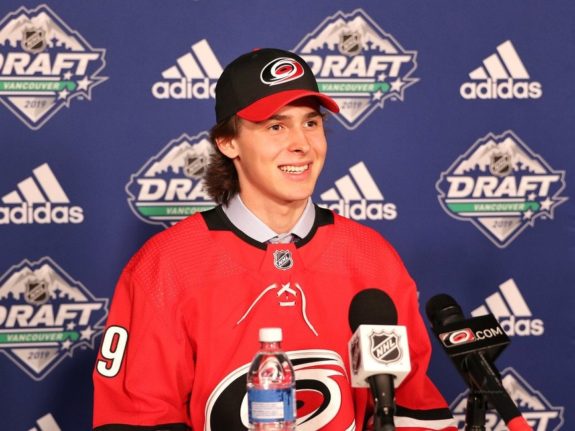
Finally, I decided to give Makiniemi a shout because of his large jump taken in the 2020-21 season. The Finnish goalie was a player I had about written off, but after a very good season in Liiga, the Hurricanes clearly liked him enough to sign him to an entry-level deal back in May. He had bouts of inconsistency, as evidenced by a mediocre .907 SV%, but when he was on his game he showed the ability to steal games for Ilves.
Final Thoughts
So, there you have it; what I think is as close to an ideal lineup as possible (while still largely being logical) for the Hurricanes three years down the road. With so much up in the air this is a tad tough, and I don’t simply mean situations like Hamilton’s contract negotiation — the flat cap, the expansion draft — there are a multitude of variables that we have no idea how will unfold. However, if I’m general manager Waddell, I’m looking to build out my team along these lines.
We have the Hurricanes allowing some of their top prospects to graduate and slide into roles suitable to their skillsets, adding some physicality and meanness without sacrificing any effectiveness (read: not rostering ineffective physical players like Cedric Paquette or Jani Hakanpää), and letting go of some bottom-of-the-roster players, such as Foegele and Jordan Martinook, replacing them with more offensively gifted types such as Suzuki and Rees.
The Hurricanes’ future is bright either way, but the next couple of years could be the defining ones of the Waddell regime. Adding some pieces like Saad, Tkachuk, and Dumba, while only losing prospects, likely a couple picks, and Necas (which, obviously, would sting), would certainly look good on his track record. Obviously, without knowing how the contract situations or chemistry levels would work out (on the former, for what it’s worth, I played around with contracts for every player listed here and came out around $84 million; tough, but doable, we’ll just have to see if the cap increases much over the next few years and if any players would be willing to come in below market rate), I think this team is a huge problem in the NHL, and could quite possibly win a Stanley Cup or two in their years together.
Leave a comment below and let me know what you think of this roster, what you would do differently, or simply what you think the Hurricanes need to be aiming for over the next couple years.